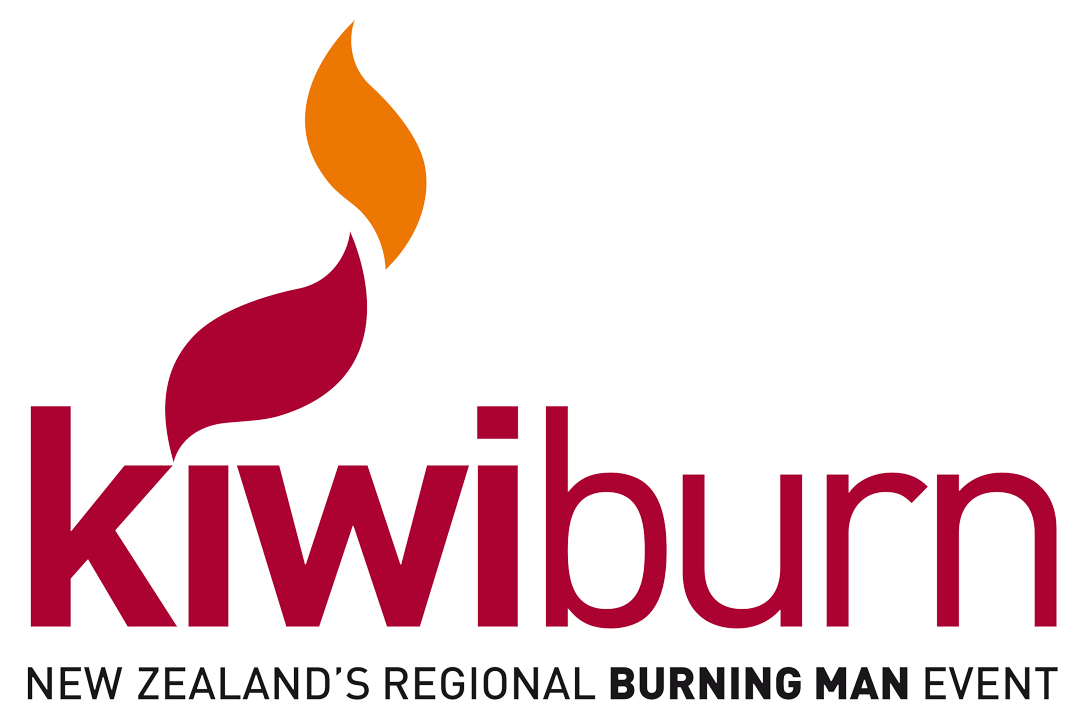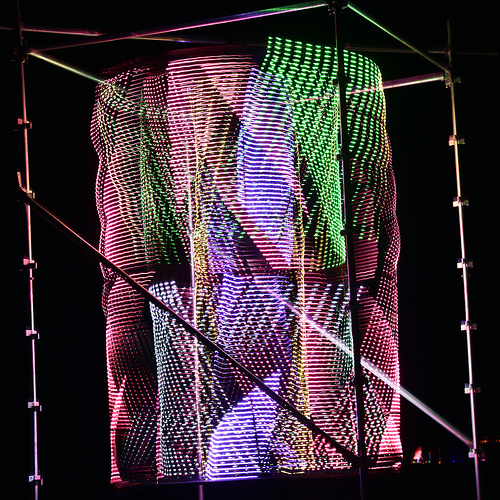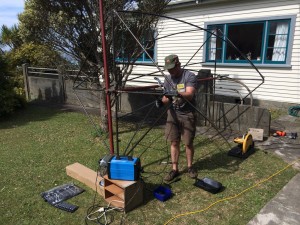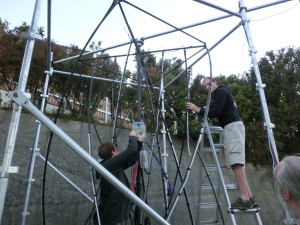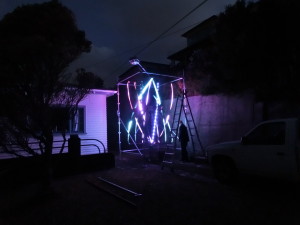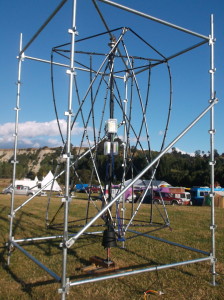By Joel Pitt
I’m one of the creators of Tensegrity, a spinning 3m tall metal and LED light sculpture that we took to Kiwiburn Wyrd in 2015.
The previous year (2014) I’d brought the Sensorium to The Paddock, which was my first exploration into electronics, construction, and art installations. While there were lots of ups and downs, things breaking, and learning from experience, after the event I came away inspired to do something bigger and better! There was something addictive about watching people interact with a thing you’d made, even without them knowing you were the one to make it. The creation of something outside of your self that exists on its own.
So at one Friday gathering of Wellington burners, I brain-stormed with friends and we literally sketched designs on napkins. Like previous burns, the rough concept for tensegrity took shape not long after the last burn had ended and my brain was humming with ideas for the next one. The Sensorium was a static light installation, and I wanted my next art piece to be kinetic. I was inspired by the work of several other people (not least of which is Happyinmotion and his Mitochondrion) where fast moving LEDs could create a persistence of vision effect. I like to make stuff that messes with people’s head even if they are completely sober.
While I was amped to bring Tensegrity to the paddock no matter what, I realised it wasn’t going to be cheap. The Sensorium cost > $1200 in components, and Tensegrity was going to involve more tools and materials. This is when other burners suggested I apply for an art grant from the Kiwiburn AGC (Art Grant Committee). I thought “hey, why not!” and felt I’d proved I could bring cool art to the paddock with The Sensorium, so hopefully that’d convince them I had a realistic shot at making Tensegrity happen too.
Eventually the AGC got back to me and I was stoked to get the good news that I’d been awarded a grant. Stoked, but then also freaked out… I realised I’d actually have to step up and get a move on. This was a good motivator to get started, if people are entrusting you with free money to bring your art to life, you don’t want to let them down!
This led to calling on many friends for advice and help. Two of which, Patrick Herd and Felicia Ullstad, jumped fully on board and put just as much effort as I did into the art’s construction. It helped that Patrick had a wealth of engineering experience to draw on, solving many of the construction challenges that were mysteries to me. We proceeded to spend a lot of the summer holiday working on the structure. I learnt to weld, among many other skills for working with metal.
During the construction, it became clear that some things were taking longer than others and we were running out of time. We came up with a plan for what things should take priority over others. We decided that the electric motor powering the structure was going to be too much work in the last week, plus it was a potential safety hazard for people interacting with the art. This actually worked out well because it made the art more participatory as people had to spin the art themselves… but the full effect of the piece could only be appreciated from several meters back, so people had to take turns spinning it for their friends 🙂
Getting to Kiwiburn was a matter of hiring a trailer, filling it to capacity and driving slowly to KiwiBurn two days early. It took a full day to set things up with help from burners, including hiding from the brutal NZ sun when it became too much. Arriving early meant that when the gates opened I could stand back and enjoy the rest of the event.
Creating art installations has become a new hobby for me, and I blame Kiwiburn for getting me hooked 😉
An almost complete build summary with lots of photos is available here.
Takeaways for would-be big art makers:
– If applying for a grant, give the AGC as much info as possible. Enthusiastic rambling about how awesome your art will be isn’t enough to convince them that you are also capable of following through, so give a decent and honest attempt at answering each question. Even the boring ones. I hear that the AGC really appreciates it when they get a detailed submission!
– If you’re just getting started. Consider bringing a smaller art piece that doesn’t cost heaps. This will show people you can follow through when you say you’ll bring something to the burn. Of course, even the best laid plans can go awry, so this isn’t a dis of the awesome artists that run into setbacks while bringing their art to the paddock. And there’s always the next year!
– Unless you’ve done something almost exactly the same before, it will probably cost more than you budget for due to unforeseen components needed, things breaking, or tools you need to hire/buy because you can’t find someone to borrow from. Bear that in mind while thinking about the $.
– Kiwiburn is great for having random people help you out with work on-site, but consider bringing on friends and coconspirators to work with. Turning the hard work into a social event as well could make it easier to motivate yourself and help share frustration when things don’t quite work and the elation of success is sweeter with others.
– If you’re doing something big. Try to split the project up into the necessities and nice to haves. When it comes to crunch time in the week leading up to the burn, you’ll probably have to give up on some cool aspect of the art you wanted to have. If you can prioritise things, and set it up so that it’ll be awesome even if you only do 75% of the project, then you can avoid burning yourself out with stress at trying to complete everything before the burn.
[share title=”Share this Post” facebook=”true” twitter=”true” google_plus=”true” pinterest=”true” email=”true”]
